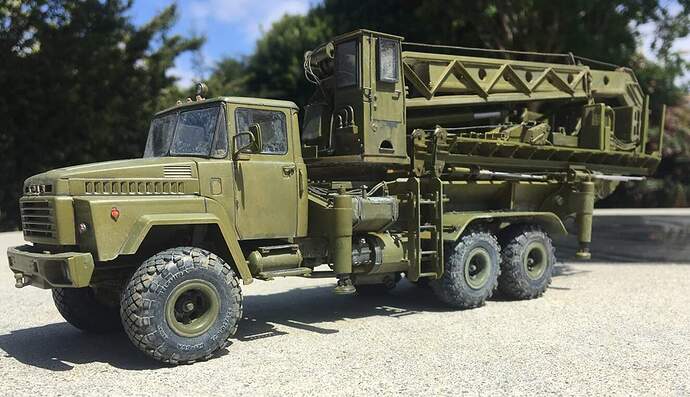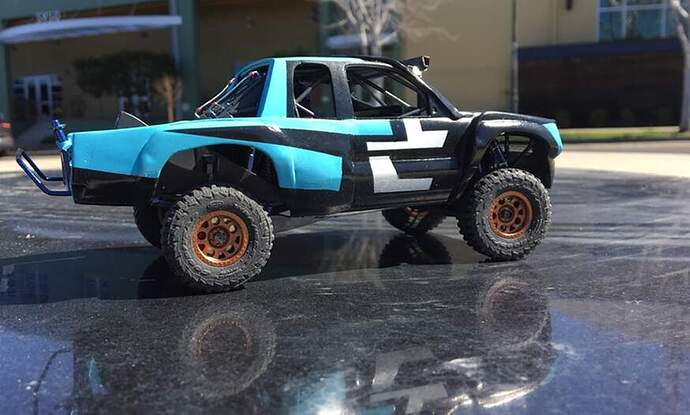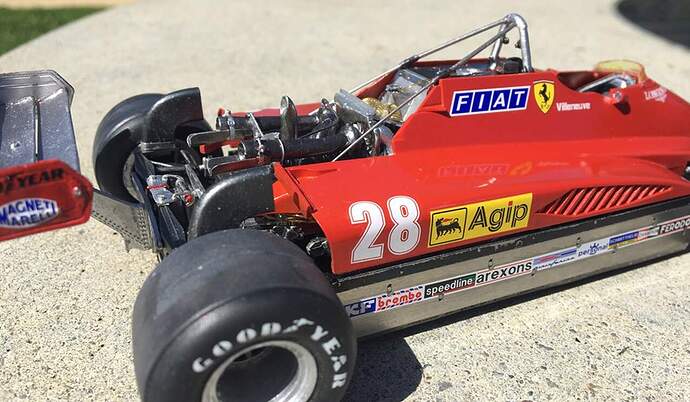I have had no problem airbrushing Vallejo Model Air, old bottles benefit from Flow Improver, but I have found that the most recent ones I bought work perfectly fine out of the bottle.
Vallejo. Model Air if you have an airbrush, Model Color if you don’t
Model Color is excellent for hand brushing,but I have no problems at all airbrushing it using their thinner and flo improver,I mean not even a second thought.
I hate them both. Vallejo is the only paint range of which I tossed my complete stock in the dustbin. It clogs the airbrush, has problem adhering to the surface … Most likely this is only my personal problem as some others seem to like it.
An other factor is that when I buy paint I want it to be a complete product. I have NO ambition making my own paints and to mess around with flow improvers, retarders, thinners … All variables that may lead to a ruined paint job and model.
I stick to Humbrol enamel, clean and simple; and to Alclad II enamels (although this seems to be off the market now?) straight from the bottle or with a drop of thinner.
I prefer to use a tested product that I am familiar with than to experiment and ruin the paint job.
Neither do I, but then I have been using them for 20yrs. Someone starting out with them, I would just recommend the Model Air, as they are consistent throughout. Model color isn’t consistent when thinning as it depends on the color. Some require more or less thinning.
Model Air, 5 parts paint, 1 part thinner, and spray. Doesn’t get much easier.
Alclad : straight from the bottle ![]()
I’m trying Vallejo Model Air for the first time on my A-20. I’ve only sprayed the neutral gray undersides so far. This was over a primer coat of MrSurfacer1500 Black which was lightly sanded.
My two observations so far are the feel of this stuff even after several hours is more rubbery than the Tamiya paint(and MrLeveling Thinner) I am used to using. I can’t speak for the toughness yet, but I used a flow improver and their thinner and was able to get it to work after a fashion.
It doesn’t seem to thin down as nicely as Tamiya paint making it harder to to do black basing (at least so far, this may be due to inexperience with Vallejo).
I’m hoping an overcoat of Tamiya clear will improve the strength of the finish and the feel.
Continuing the discussion from AK Or Vallejo:
To Answer phantom_phanatic US Lacquer is UK Cellulose.
I frequently use Mr Color Levelling thinners with TAMIYA Acrylic, goes down smooth, no drama, doesn’t tip dry anything like Vallejo.
(Hint I often use the above AS my primer AND topcoat!)
Caveat, I’ve never tried to thin VJ or AK with it.
Another vote for AK here, I really like the WW2 UK & German Armour colours, they spray superbly, thinned with VJ Airbrush thinner.
VJ, even ModelAir, most problematical, even when using VJ Airbrush thinner, and their retarder, lots of tip-dry, clogging, & then often doesn’t stick well! last choice for me now.
This is the perfect summary why I hate this stuff. Why should I buy an expensive paint if I have to go through this length (and partly re-design the paint itself) to use it.
That’s a more than fair argument.
I am old fashioned. I use a 3M mask with active coal for spraying , and a home made booth (that desperately needs an update) also with a large active coal filter.
Great for the 20 or so color they have and if you want to paint something a metallic shade. Otherwise kinda useless for normal colors
Your info is slightly outdated. They have a rather large enamel range these days.![]() but they seem to be in trouble thanks to brexit. Their site told us during more than a year that they could not sell on the european market, and is now down completely. Apparently they started a new brand but i cant find much on that either
but they seem to be in trouble thanks to brexit. Their site told us during more than a year that they could not sell on the european market, and is now down completely. Apparently they started a new brand but i cant find much on that either
None of which is available in North America. Just the metallics and candies here.
I mean if you want to use enamels, great, but they are getting harder and hard to ship anywhere due to their chemical make up.
Acrylics can be shipped anywhere.
Vallejo is not that hard to use, like anything, just have to use it properly. 99.9% of the problems with Vallejo, comes down to user error.
I use a fair amount of Vallejo Model Air and Metal Color and have had success with both.
OH Shoot! - just noticed this is for aircraft! (after posting) - don’t mean to cause any grief - maybe helpful - if not, I’ll delete! ![]()
I use Badger Patriot and Krome airbrushes - the former for big surfaces, the later for finer work. I’ve found the Model Air works easily most of the time when using the Patriot, but can clog in the Krome.
As I recall, my compressor is by Iwata - something like “smart air”? not sure tho. I got it because it’s quiet. I have an inline water trap, but don’t know how to adjust the air pressure - or if I can? ![]()
Clogging seems to occur with old or coagulated paint, or when I have some gunk in airbrush. I usually flush the airbrush immediately after use - but, sometimes no luck, so I’ve gotten pretty good at tearing apart, cleaning, and quickly reassembling ![]() I generally expect to do this if I haven’t used the brush in a while.
I generally expect to do this if I haven’t used the brush in a while.
Here are some examples of results with Vallejo Model Air:
The Kraz on top received Vallejo IDF grey primer, then various shades of green, then several washes of Life Color dust. The tires are painted with Vallejo Model Air NATO Black
The F1 car and the Peterbilt have Tamiya can fine grey primer, the car is painted with Vallejo French Blue, and the truck Ferrari red, and both have several coats of Aqua Gloss II clear coats. The truck tires are Vallejo NATO Black
The race truck is painted with Vallejo Model Air only, and no clear coat, and while crisp, the colors are matte. The wheels are painted with Vallejo Metal Color
I don’t add anything to the paint. I shoot the Metal Color through the Krome airbrush because it is very fine - almost like water and the Patriot blasts it out too quickly.
Using reds, oranges, and yellows with model air often require several thin layers to be applied to build up to the desired color, and you need to be careful with the color of your primer. The car below is also Ferrari red, but with a pink primer base:
You can see it’s brighter than the finish on the Peterbilt, and, with some (tedious) effort using several coats of clear coat, and intermittent use of micro film, really fine sand paper, and eventually polish, you can get a pretty nice finish.
So yes, I’m a Vallejo fan. I used AK when they first came out, and loved it, but began having trouble with the paint doing strange things - drying with unusual ring like patterns on flat surfaces. This happened with shades of desert sand. I eventually got annoyed enough to try the Vallejo version. I am guessing that AK has resolved that by now, but I now have a pretty big variety of Vallejo colors here.
Cheers
Nick
I have multiple thoughts on vallejo. I use both air and the model color. I used to use the primer.
If I could do it all over I would probably not do VA. But I have gotten very good results with it when its good for the air brush. However I learned one variable thats important with going VA.
a. How you store it is a factor.
b. How old is the paint, you might possibly never know as who knows how long that model shop has had
it on the shelf. My shop has had bottles on the shelf for years.
c. If ordering it, you might not be able to control how it was exposed on the trucks or warehouse temps.
not sure how that effects other brands. But Vallejo is finicky.
d. I paint all my models with Model master primers or Tamiya spray can primers. Not the vallejo bottle
primer. VA loves to absorb into the primers and its very satisfying. They are dry to the touch within
minutes if sprayed above 80.
Age is not really a factor, I have bottles in my stash that are 10+yrs old and work the same and just as well as a brand new bottle.
Biggest thing that kills a bottle of Vallejo is the temperature. While they do have some tolerance to cold, and actually freezing, they can only handle a handful of freeze/thaw cycles. Once they go past that, they are junk, and turn to sludge.
I use Vallejo Model Colour. It brushes on nicely and self levels. For air brushing I thin it with denatured water sometimes it is called distilled water. It works fine. Before air brushing I put it through a fine screen, After it is totally dry I give the model a spray of Krylon Artists clear mat acrylic to preserve the finish.
A number of major acrylic paint manufacturers, including Vallejo, are currently reformulating and rolling out new paint. Formulations are changing. Colors are changing. Support products are changing.
The paint accuracy war is waged on a color by color basis. It is utterly hopeless to pick a paint line because it has the ‘most accurate’ colors.
The solvent used to thin a paint drastically changes a bunch of factors in performance. Mapping all that out across multiple paint lines is very complex.
Both AK and Vallejo have sub paint lines that behave drastically different from one another.
No matter what you choose, expect a learning curve. It can be severe. Start on cheap, quick to build models until you have your sea legs.
I’ve only used Model Air a few times, but yes, it has a quite rubbery feel on its’ own. That’s just a characteristic of the paint. Gloss & Flat overcoats change that, obviously. It works ok for black basing, but not as good as Tamiya or AK Real Color.




